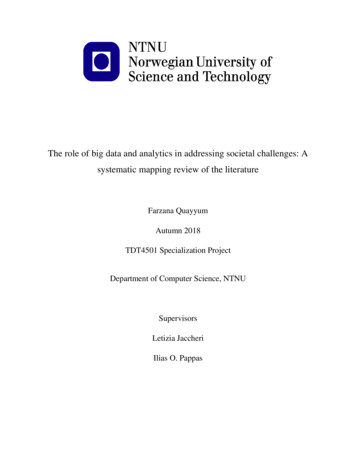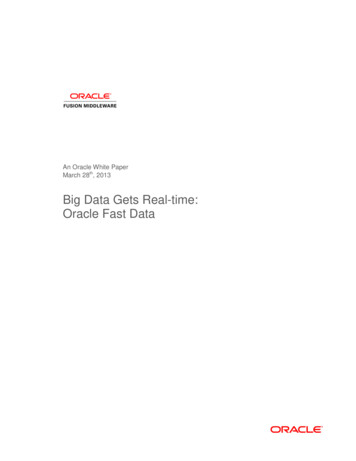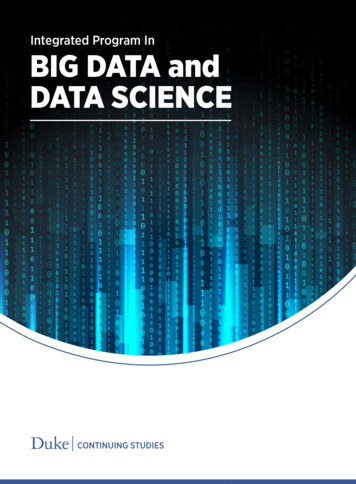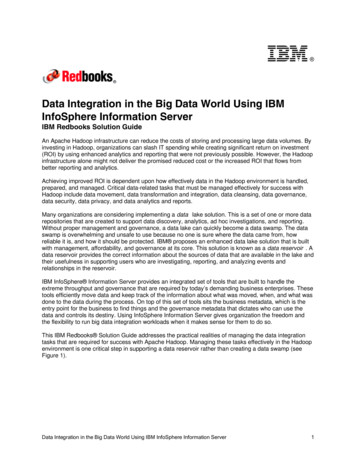
Transcription
The role of big data and analytics in addressing societal challenges: Asystematic mapping review of the literatureFarzana QuayyumAutumn 2018TDT4501 Specialization ProjectDepartment of Computer Science, NTNUSupervisorsLetizia JaccheriIlias O. Pappas
AbstractBig data has recently become the focus of academic and corporate investigation due to the highoperational and strategic potential of it in generating business and social value. The objective ofthis paper is to offer a map of the research that is being done, thus offering the basis for areflection process among the researchers in this field. We have done a systematic mapping of theliterature related to big data and analytics and their applications leading to social change throughthe lens of social innovation. This mapping study in this area will allow us to develop a researchagenda and roadmap of big data and analytics and their applications leading to social change.KeywordsBig Data, Data Analytics, Social Innovation, Societal Transformation, Social Change, SocialGood, Systematic Mapping Study
PrefaceThis thesis is submitted to the Norwegian University of Science and Technology (NTNU) as partof the course TDT4501 Computer Science, Specialization Project.The work has been performed at the Department of Computer Science, NTNU, Trondheim,under the supervision of Professor Letizia Jaccheri as the main supervisor and Post-DoctoralFellow Ilias O. Pappas as co-supervisor.
Table of Contents1. Introduction . 61.1 Motivation . 61.2 Research Questions 81.3 Research Method 91.4 Outline of the Thesis . 92. Background . 102.1 Big Data .112.2 Social Innovation . 122.3 Big Data and Social Innovation 143. Research method . 173.1 Mapping Procedure . 183.2 Research Questions . 183.3 Data Sources and Search Strategy 193.4 Study Selection . 203.5 Manual Search . 213.6 Data Extraction . 213.7 Validity of Review 224. Results and Findings . 234.1 RQ1 How the research about ‘big data and social innovation' has changedover time (in the last decade)? . 234.1.1Publication Frequency . 234.1.2Research Areas . 244.1.3Publication Sources . 254.2 RQ2 How much of the research is done based on empirical studies and whattype of empirical studies? 264.2.1Empirical Evidence . 264.2.2Contribution Type . 294.3 RQ3 What are the drivers, enablers, and barriers for the successfulimplementation of big data for social innovation/change? . 31
4.3.1Challenges of implementing Big data for social innovation 324.3.2Overall challenges of implementing Big data . 325. Discussion . 345.1 Findings from Research Questions . 345.2 Use of Keywords . 375.3 Theory behind Studies . 375.4 Limitations of the study . 386. Planning of Future Work . 396.1 Observation from Mapping Study . 396.2 Problem areas and Research Questions . 396.3 Research Plan and Approach . 406.3.1Research Process . 406.3.2Participants . 416.3.3Research Paradigm . 426.3.4Contributions . 426.3.5Final Deliverables and Dissemination . 427. Conclusion . 43References 44Appendix . 48
Chapter 1IntroductionThe evolution of Information and Communication Technology drives the digitalization processin many aspects of peoples' daily lives. With this digitalization process, a huge amount of datagenerates every moment from a growing number of sources. The term “big data” is used todescribe this growing proliferation of data and our increasing ability to make productive use of it.In the last decade, the use of big data and data analytics has earned a lot of attention. In variousfields of science, technology, and business, the merit of big data is undeniable. But from thesocial perspective, the potential use of big data is yet to be figured out by social sectororganizations. To harness the power of big data, to increase collective and individual awarenessabout societal problems existing in the society, and ultimately to create the needed intelligencethat will lead to innovative solutions for societal problems is still a challenge. This study aims toprovide an up to date overview of the research within the field of big data and social innovation,structuring and analyzing the literature between 2008-2018.In this study, we use big data and data analytics interchangeably. From the literature, we see thatbig data and data analytics can be used interchangeably because the term “big data” does not justrefer to large sets of data but also refers to analytical tools used to manage these large sets of dataand turn them into useful and productive information. A couple of examples are Siemens andLong (2011), who define big data as “datasets whose size is beyond the ability of typicaldatabase software tools to capture, store, manage and analyze” and Chen, Chiang, and Storey(2012), who call it "data sets that is so large (from terabytes to exabytes) and complex (fromthe sensor to social media data) that they require advanced and unique storage, management,analysis, and visualization technologies." These definitions show that the authors think of bigdata in terms of how it gets analyzed, not how many specific terabytes of space it fills (D.Maltby, 2011).In this paper, we also use the terms social innovation, social good, social change, and societaltransformation interchangeably. Social innovation is defined as a novel solution to a socialproblem that is more effective, efficient, sustainable, or just than existing solutions and for whichthe value created accrues primarily to society as a whole rather than private individuals (Phills et6
al, 2008). Social innovation is a great way for creating social good and transforming andchanging the society. Social good is typically defined as an action that provides some sort ofbenefit to the people of the society. The concept of social change is to address the root causes ofproblems in society and change them. So, all these concepts are related to each other andconcerns about ideas and actions that have positive change and impact on the society. During thisstudy our focus was on the applications of big data that address social problems or challenges;so, to keep the scope of this study broad and general we use all these terms. Our focus was nosocietal transformation and change through the lens of social innovation.This introduction consists of four subsections. Section 1.1 presents the motivation and researchobjective of this research. Section 1.2 presents the research questions. Section 1.3 explains thechosen research method and the research process. Section 1.4 presents the outline of this study.1.1 MotivationThe value of big data is clear for addressing technical and business problems (Chen et al., 2012).However, research on the social value of big data is not at the same level (Agarwal and Dhar,2014, Zicari, 2014), raising the question on how well big data can be used to address complexsocial problems.There are hundreds of publications around big data and their applications, as well as anincreasing number of publications, from various fields, discussing social innovation and how itcan help societal transformation (Phillips et al., 2015, Voorberg et al., 2015) and change. Toachieve this transformation, the application of big data and analytics can help the socialinnovation process along with innovative practices, guidelines, and policies. No systematicsmapping has been done on this topic so far. So, there is a need for a mapping study in the areaallowing us to develop a research agenda and roadmap of big data and analytics and theirapplications leading to societal transformation and change.The mapping can help us to understand what conditions can enable successful solutions,combined with strategies, tactics, and theories of change that lead to lasting impact (CajaibaSantana, 2014, Pappas et al., 2017, Zicari, 2014). Furthermore, the mapping will allow capturingthe needed capabilities, resources, and conditions that the big data actors need to develop or7
acquire in order to manage big data applications, increase social value and solve societalchallenges and create a sustainable society. To contribute to the creation of sustainable societies,we have done a systematic mapping of the literature related to big data and their applicationsleading to social innovation and thus societal transformation. A systematic mapping review is aprocess to analyze the properties of the research papers in a specific research field (Petersen etal., 2015). The objective is to offer a map of the research that is being done, thus offering thebasis for a reflection process among the researchers in this field.There are many challenges in harnessing the potential of big data today, ranging from the designof processing systems at the lower layer to analysis means at the higher layer, as well as a seriesof open problems in scientific research (Jin et al., 2015). Among these challenges some arecaused by the characteristics of big data and some are related to the data processing systems andalso other contextual problems. Big data has many characteristics and various properties likevolume, velocity, variety, variability, value and complexity of these properties put forward manychallenges. Since Big data is a recent upcoming technology in the market which can bring hugebenefits for organizations, it becomes necessary that various challenges and issues associated inbringing and adapting to this technology are brought into light (Katal et al, 2013). From thismapping review we will try to find out what are the challenges and barriers faced by socialinnovators and organizations when they attempt to employ big data analytic tools to addresssocial problems through social innovation.1.2 Research QuestionsThe research objective of this thesis is to understand the latest research status of big data andtheir implications on societal transformation and change, and then identify the gaps andchallenges that we need overcome in order to transform society. But there is a lack ofunderstanding about how big data can be used for social innovation and how it can help societaltransformation and change. To solve existing social problems, to achieve societal transformationor change, the applications of big data can help immensely.From this thesis, we aim to answer the following research questions:RQ1: How the research about ‘big data and social innovation' has changed over time (in the lastdecade)?8
RQ2: How much of the research is done based on empirical studies and what types of empiricalstudies?RQ3: What are the challenges or barriers for successful implementation of big data for societalchallenges?1.3 Research MethodTo address the research objective and the research questions, we have done a systematicmapping study (Petersen et al., 2008). Systematic mapping study is a method used for theanalysis of published literature in a wide research area. We have followed the standardizedprocess for systematic mapping studies (Petersen et al., 2008). The main steps of the processinclude the research questions to be answered, search and study selection strategies, manualsearch, and data extraction and synthesis. Based on the primary search with search strings, total593 unduplicated papers were retrieved. After applying some exclusion criteria, the number wasreduced to 165 (based on titles), then 153 (based on abstracts) and finally 146 were selected fromthe search and later 10 more papers were added manually from Google scholar.1.4 Outline of the ThesisThis project report proceeds as follows: Section 2 introduces the background of this study, Then,section 3 explains the detailed procedure of the research method, section 4 presents the resultsand findings of the mapping study, section 5 discusses the findings in relation to the researchquestions, section 6 presents future work and the research plan that will be conducted as part ofthis thesis during spring 2019. Then section 7 concludes the paper presenting the implications ofthis study. A list of the reference papers from this mapping is also included at the end of thispaper.9
Chapter 2BackgroundDue to the high operational and strategic potential of big data in generating value, “big data” hasrecently become the focus of the academic and corporate investigation (Wamba et al., 2014).Academics and practitioners are interested in understanding the impacts of big data. The use ofbig data and data analytics, the notion of ‘smart’ environment has earned a lot of attention fromboth the academic and business world. In various fields of science, technology, and business, themerit of big data is undeniable. It is a time of opportunity for social scientists that haveheretofore been hamstrung by the lack of data (Agarwal & Dhar, 2014). Data-driven intelligencehas been used successfully in technical and business endeavors, but a very different situationprevails in the social arena. There, a large chasm exists between the potential of data-driveninformation and its actual use in helping solve social problems. (Desouza & Smith, 2014).Big data can have implicat
Big Data, Data Analytics, Social Innovation, Societal Transformation, Social Change, Social Good, Systematic Mapping Study . Preface This thesis is submitted to the Norwegian University of Science and Technology (NTNU) as part of the course TDT4501 Computer Science, Specialization Project. The work has been performed at the Department of Computer Science, NTNU, Trondheim, under the











